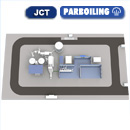Rice, a staple food for half of the world's population, has a rich history intertwined with the evolution of technology. From ancient hand-pounding techniques to modern industrial machinery, the processing of rice has undergone significant changes over the centuries. In this article, we will delve into the fascinating journey of how rice processing technology has evolved, exploring the innovative methods and machinery that have revolutionized this essential global industry. Join us as we uncover the intricate web of advancements that have shaped the way we process this essential grain.
Innovations in Traditional Rice Processing Techniques
With the continuous advancements in technology, traditional rice processing techniques have seen significant innovations over the years. These innovations have not only streamlined the process but also improved efficiency and quality. New methods have been developed to enhance traditional techniques, making rice processing faster and more cost-effective. One such innovation is the introduction of automated rice milling machines, which can process large quantities of rice in a fraction of the time it would take with manual labor.
Additionally, modern rice processing equipment now includes sophisticated sorting and grading systems that ensure only the highest quality rice grains are selected for packaging. This not only enhances the overall product quality but also reduces wastage by eliminating defective grains. Moreover, have led to the development of new products such as fortified rice, which is enriched with essential nutrients to address nutritional deficiencies in populations that rely heavily on rice as a staple food.
Efficient Modern Methods for Rice Milling
Rice milling has come a long way from traditional methods to modern, efficient processes that save time and resources. One of the most notable advancements in rice processing technology is the introduction of automated machinery that can handle large quantities of rice with precision and speed. These machines use advanced sorting, cleaning, and milling techniques to ensure high-quality rice grains.
Another important development in rice milling technology is the use of computer programs and software to optimize the milling process. Through data analysis and monitoring, these programs can identify areas for improvement and increase overall efficiency. Additionally, innovations such as the use of infrared technology for quality control and the development of eco-friendly practices in rice processing have further revolutionized the industry.
Impact of Technology on Quality and Yield of Processed Rice
Technological advancements have greatly revolutionized the way rice is processed, leading to significant improvements in both quality and yield. One of the key innovations in rice processing technology is the introduction of automated milling machines. These machines are capable of processing rice at a much faster rate than traditional methods, resulting in increased efficiency and higher yields.
Furthermore, the use of precision technologies such as laser sorting systems has improved the quality of processed rice by allowing for the removal of defective grains and foreign materials. This ensures that only the highest quality rice grains make it to the final product, enhancing the overall quality of the processed rice. Overall, the evolution of rice processing technology has had a profound impact on both the quality and yield of processed rice, making it more efficient and reliable than ever before.
Recommendations for Adopting Sustainable Rice Processing Practices
When it comes to adopting sustainable rice processing practices, it's important to some key recommendations
- Implement Water-saving Techniques: Utilize technologies such as closed-loop water systems and water recycling to minimize water usage during processing.
- Invest in Energy-efficient Equipment: Upgrade processing equipment to energy-efficient models to reduce electricity consumption and lower carbon emissions.
- Use Eco-friendly Packaging: Switch to biodegradable or recyclable packaging materials to reduce environmental impact.
Another important aspect is to prioritize waste management and recycling procedures in rice processing facilities. Implementing composting programs for organic waste and setting up recycling stations for packaging materials can significantly reduce the overall waste output of the operation. By adopting these sustainable practices, rice processors can not only reduce their environmental footprint but also contribute to the long-term sustainability of the industry as a whole.
The Way Forward
In conclusion, the evolution of rice processing technology has played a pivotal role in enhancing the efficiency and sustainability of rice production around the world. From traditional methods to modern innovations, each step forward has brought us closer to achieving greater yields and higher quality rice for consumers. As we continue to explore new advancements in this field, it is clear that the journey towards perfection is far from over. With each new discovery, we move closer to unlocking the full potential of this staple crop, ensuring a brighter and more prosperous future for all.

